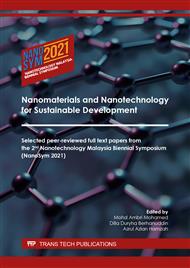[1]
S. A. Mirmohammadi, S. Sadjadi, and N. Bahri-laleh, 10 - Electrical and Electromagnetic Properties of CNT/Polymer Composites. Elsevier Inc., (2018).
DOI: 10.1016/b978-0-323-48221-9.00010-8
Google Scholar
[2]
S. M. Sultan, S. H. Pu, S. J. Fishlock, L. H. Wah, H. M. H. Chong, and J. W. McBride, Electrical behavior of nanocrystalline graphite/p-Si Schottky diode,, 16th Int. Conf. Nanotechnol. - IEEE NANO 2016, p.307–310, Nov. (2016).
DOI: 10.1109/nano.2016.7751379
Google Scholar
[3]
Z. Zhu, An Overview of Carbon Nanotubes and Graphene for Biosensing Applications,, Nano-Micro Lett., vol. 9, no. 3, p.1–24, (2017).
Google Scholar
[4]
A. A. Chlaihawi, B. B. Narakathu, A. Eshkeiti, S. Emamian, S. G. R. Avuthu, and M. Z. Atashbar, Screen Printed MWCNT/PDMS Based Dry Electrode Sensor for Electrocardiogram (ECG) Measurements,, p.526–529, (2015).
DOI: 10.1109/eit.2015.7293392
Google Scholar
[5]
A. A. Nawawi, S. M. Sultan, S. F. A. Rahman, P. I. Khalid, and S. H. Pu, Reverse biased nanocrystalline graphite (NCG)/p-Si schottky junction for methane gas sensor,, Indones. J. Electr. Eng. Comput. Sci., vol. 15, no. 3, p.1217–1222, Sep. (2019).
DOI: 10.11591/ijeecs.v15.i3.pp1217-1222
Google Scholar
[6]
H. Kumar, N. Kumari, and R. Sharma, Nanocomposites (conducting polymer and nanoparticles) based electrochemical biosensor for the detection of environment pollutant: Its issues and challenges,, Environ. Impact Assess. Rev., vol. 85, no. June, p.106438, (2020).
DOI: 10.1016/j.eiar.2020.106438
Google Scholar
[7]
J. R. Siqueira and O. N. Oliveira, Carbon-Based Nanomaterials,, 2017, p.233–249.
Google Scholar
[8]
R. P. Tripathi, A. Tiwari, and G. R. Mishra, Design and Fabrication of a Nano Patch Electrode for ECG using CNT/PDMS,, p.335–339, (2017).
DOI: 10.1109/iccmc.2017.8282703
Google Scholar
[9]
A. Nilchian and C. Z. Li, Mechanical and electrochemical characterization of CNT/PDMS composited soft and stretchable electrodes fabricated by an efficient solution-based fabrication method,, J. Electroanal. Chem., vol. 781, p.166–173, (2016).
DOI: 10.1016/j.jelechem.2016.08.013
Google Scholar
[10]
D. Ryoo, J. Y. Kim, P. K. Duy, S. H. Cho, H. Chung, and T. H. Yoon, Fast and non-destructive Raman spectroscopic determination of multi-walled carbon nanotube (MWCNT) contents in MWCNT/polydimethylsiloxane composites,, Analyst, vol. 143, no. 18, p.4347–4353, (2018).
DOI: 10.1039/c8an00351c
Google Scholar
[11]
N. Deep and P. Mishra, Fabrication and characterization of thermally conductive PMMA/MWCNT nanocomposites,, Mater. Today Proc., vol. 5, no. 14, p.28328–28336, (2018).
DOI: 10.1016/j.matpr.2018.10.117
Google Scholar
[12]
A. A. Chlaihawi et al., Development of flexible dry ECG electrodes based on MWCNT/PDMS composite,, 2015 IEEE SENSORS - Proc., p.1–4, (2015).
DOI: 10.1109/icsens.2015.7370218
Google Scholar
[13]
Y. Huangfu et al., Fabrication and investigation on the PANI/MWCNT/thermally annealed graphene aerogel/epoxy electromagnetic interference shielding nanocomposites,, Compos. Part A Appl. Sci. Manuf., vol. 121, no. March, p.265–272, (2019).
DOI: 10.1016/j.compositesa.2019.03.041
Google Scholar
[14]
A. Achilli, A. Bonfiglio, and D. Pani, Design and characterization of screen-printed textile electrodes for ECG monitoring,, IEEE Sens. J., vol. 18, no. 10, p.4097–4107, (2018).
DOI: 10.1109/jsen.2018.2819202
Google Scholar
[15]
R. Castrillón, J. J. Pérez, and H. Andrade-Caicedo, Electrical performance of PEDOT: PSS-based textile electrodes for wearable ECG monitoring: A comparative study,, Biomed. Eng. Online, vol. 17, no. 1, p.1–23, (2018).
DOI: 10.1186/s12938-018-0469-5
Google Scholar
[16]
Y. Karatas, E. Kuyuldar, H. Acidereli, M. Gulcan, and F. Sen, Polypyrrole-multi walled carbon nanotube hybrid material supported Pt NPs for hydrogen evolution from the hydrolysis of MeAB at mild conditions,, Sci. Rep., vol. 9, no. 1, p.1–8, (2019).
DOI: 10.1038/s41598-019-55030-z
Google Scholar
[17]
B. Earp et al., Electrically conductive CNT composites at loadings below theoretical percolation values,, Nanomaterials, vol. 9, no. 4, p.1–17, (2019).
DOI: 10.3390/nano9040491
Google Scholar
[18]
S. L. Marasso and P. Rivolo, Experimental study of PDMS mechanical properties for the optimization of polymer based flexible pressure micro-sensors Experimental study of PDMS mechanical properties for the optimization of polymer based flexible pressure micro-sensors,, (2016).
DOI: 10.1088/1742-6596/757/1/012009
Google Scholar
[19]
E. Pullicino, W. Zou, M. Gresil, and C. Soutis, The Effect of Shear Mixing Speed and Time on the Mechanical Properties of GNP/Epoxy Composites,, Appl. Compos. Mater., vol. 24, no. 2, p.301–311, (2017).
DOI: 10.1007/s10443-016-9559-3
Google Scholar
[20]
W. C. Wong, P. L. Teh, A. F. Osman, and C. K. Yeoh, The properties of epoxy/graphene conductive materials using high speed mechanical stirrer and bath sonicator,, Mater. Sci. Forum, vol. 888 MSF, p.222–227, (2017).
DOI: 10.4028/www.scientific.net/msf.888.222
Google Scholar
[21]
M. Chi, J. Zhao, Y. Dong, and X. Wang, Flexible Carbon Nanotube-Based Polymer Electrode for Long-Term Electrocardiographic Recording,, Materials (Basel)., vol. 12, no. 6, p.971, (2019).
DOI: 10.3390/ma12060971
Google Scholar
[22]
A. Kumar, U. Banerjee, M. K. Chowrasia, H. Shekhar, and M. K. Banerjee, Effect of MWCNT Content on the Structure and Properties of Spark Plasma-Sintered Iron-MWCNT Composites Synthesized by High-Energy Ball Milling,, J. Mater. Eng. Perform., vol. 28, no. 5, p.2983–3000, (2019).
DOI: 10.1007/s11665-019-04056-5
Google Scholar
[23]
T. Mulembo, G. Nagai, H. Tamagawa, T. Nitta, and M. Sasaki, Conductive and flexible multi-walled carbon nanotube/polydimethylsiloxane composites made with naphthalene/toluene mixture,, J. Appl. Polym. Sci., vol. 136, no. 44, p.1–8, (2019).
DOI: 10.1002/app.48167
Google Scholar
[24]
C. Xuan Liu, Improved Dispersion of Carbon Nanotubes in Polymers at High Concentrations,, p.329–347, (2012).
Google Scholar
[25]
J. H. Kim et al., Simple and cost-effective method of highly conductive and elastic carbon nanotube / polydimethylsiloxane composite for wearable electronics,, Sci. Rep., no. December 2017, p.1–11, (2018).
DOI: 10.1038/s41598-017-18209-w
Google Scholar
[26]
I. Kaur et al., Dispersion of nanomaterials in aqueous media: Towards protocol optimization,, J. Vis. Exp., vol. 2017, no. 130, p.1–23, (2017).
Google Scholar
[27]
G. Liu et al., Enhanced dielectric performance of PDMS-based three-phase percolative nanocomposite films and conductive multi-walled carbon nanotubes †,, (2018).
DOI: 10.1039/c8tc03868f
Google Scholar
[28]
S. Aslnejad, M. Nasiri, F. Abbasi, and H. Abdipour, Preparation of MWCNT/PDMS Conductive Micro-Patterned Nanocomposites,, Macromol. Res., vol. 28, no. 8, p.733–738, (2020).
DOI: 10.1007/s13233-020-8095-z
Google Scholar


